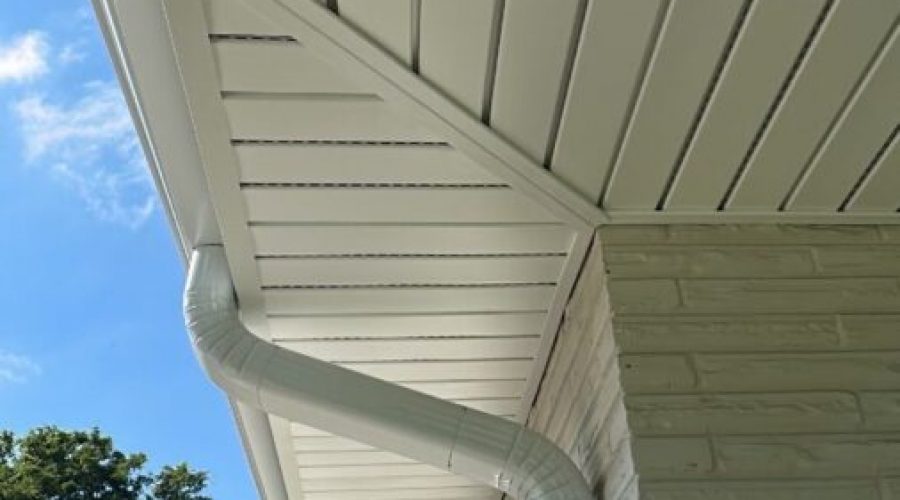When it comes to home improvement and maintenance, soffits and fascia often go unnoticed. However, these components play a vital role in safeguarding your home from the elements while enhancing its curb appeal. Whether you’re planning a new installation or replacing old materials, understanding the different types of soffits and fascia can help you make an informed decision. This guide explores the available materials, their benefits, and essential installation tips.
What Are Soffits and Fascia?
Before looking at the types of materials, it’s important to know what soffits and fascia do in your home.
Soffits
Soffits are the horizontal panels located underneath the eaves of your roof. They serve several essential functions:
Ventilation: Soffits allow air to circulate through the attic, preventing moisture buildup that can lead to mold, mildew, and wood rot.
Pest Prevention: They create a barrier against birds, rodents, and insects, preventing them from nesting in your roof’s exposed rafters.
Aesthetic Enhancement: Soffits contribute to the overall visual appeal of your home by giving the roof a finished look.
Fascia
Fascia boards run along the edge of the roofline and attach directly to the roof trusses. They provide several benefits:
Structural Support: Fascia holds the bottom row of roof tiles. It also supports the weight of gutters, helping them work well.
Weather Protection: These boards protect the edge of the roof from rain, wind, and snow.
Improved Aesthetics: Like soffits, fascia adds a polished and complete look to your home’s exterior.
Types of Soffits and Fascia
Various materials are available for soffits and fascia, each offering unique advantages and drawbacks. Here’s a closer look at the most common options:
1. Vinyl Soffits and Fascia
Vinyl soffit is a popular choice for soffits and fascia. It is affordable and easy to maintain.
Pros:
Cost-Effective: Vinyl is an economical choice compared to other materials.
Low Maintenance: It does not require frequent painting or sealing.
Weather and Pest Resistant: Vinyl resists moisture, rot, and insect damage.
Variety of Styles: Available in different colors and designs to match various home aesthetics.
Cons:
Limited Customization: The range of colors may be more restricted compared to other materials.
Brittle in Cold Weather: In extreme cold, vinyl can become brittle and prone to cracking.
2. Aluminum Soffits and Fascia
Aluminum is a durable and lightweight option, ideal for homes in areas prone to heavy rain and snow.
Pros:
Highly Durable: Resistant to rust, rot, and pest infestations.
Lightweight: Easy to install and doesn’t add extra weight to the roof structure.
Customizable: Can be painted in any color to match your home’s exterior.
Fire Resistant: Unlike wood, aluminum does not pose a fire hazard.
Cons:
Prone to Denting: Aluminum can easily dent upon impact.
Potential Corrosion: If not properly coated, it can corrode over time.
3. Wood Soffits and Fascia
Wood soffits and fascia provide a classic and natural aesthetic, often seen in traditional and high-end homes.
Pros:
Timeless Appeal: Wood offers a natural, warm look that complements many architectural styles.
Customizable: Can be stained or painted to match any home design.
Strong and Durable: Properly maintained wood can last for decades.
Cons:
High Maintenance: Requires regular sealing, staining, or painting to prevent moisture damage.
Susceptible to Rot and Pests: Wood is vulnerable to termites and weather-related decay.
4. Composite Soffits and Fascia
Composite materials combine wood fibers with synthetic elements, creating a durable and aesthetically pleasing product.
Pros:
Low Maintenance: Resistant to rot, insects, and weather damage.
Aesthetic Versatility: Available in various colors and finishes that mimic natural wood.
Durable: Offers the strength of wood without the susceptibility to moisture damage.
Cons:
Higher Upfront Cost: More expensive than vinyl and aluminum options.
Limited Availability: Not as widely available as other materials in some regions.
Soffit and Fascia Installation: What You Need to Know
Installing soffits and fascia requires precision and the right tools. Proper installation ensures adequate attic ventilation, structural integrity, and enhanced aesthetic appeal.
Steps for Soffit Installation
Preparation: Measure the eaves and cut the soffit panels to the appropriate size. Gather essential tools like a saw, hammer, nails, and a ladder.
Attach the J-Channel: The J-channel is fixed along the perimeter of the house to hold the soffit panels in place. Secure it with nails or screws, ensuring it is level and properly aligned.
Install Soffit Panels: Slide the soffit panels into the J-channel, securing them with nails. Align them evenly for a seamless appearance.
Ensure Proper Ventilation: If using solid soffit panels, install vented panel every five feet to allow adequate airflow. Solid panels are to be used on rakes section.
Install Fascia: Once the soffits are in place, attach the fascia boards along the roofline. Secure them with nails, ensuring they align properly with the soffit panels.
Maintenance Tips for Soffits and Fascia
To extend the lifespan of your soffits and fascia, follow these maintenance tips:
Regular Cleaning: Remove dirt, dust, and cobwebs using a soft brush or cloth. For vinyl and aluminum, a mild detergent with water can be used.
Inspect for Damage: Periodically check for signs of rot, cracks, or peeling paint, and address any issues promptly.
Repaint or Stain as Needed: Wood and composite materials may require occasional repainting or staining to maintain their appearance and protect against weather damage.
Ensure Proper Ventilation: Keep vents clear of debris to maintain proper attic airflow and prevent moisture buildup.
Conclusion
Soffits and fascia are essential components of your home’s roofing system, offering both functional and aesthetic benefits. By selecting the right material—whether vinyl, aluminum, wood, or composite—you can enhance your home’s durability, weather resistance, and overall appeal. Proper installation and regular maintenance will ensure these elements provide long-lasting protection. If you are building a new home or upgrading your current one, contact Pro Home Services for a free consultation. We will help you choose quality soffits and fascia that will benefit you in the long run.

